Sphinginae subfamily
Sphingini tribe:
 |
Ceratomia amyntor
WO,
the Elm Sphinx or Four-horned Sphinx
The upperside of the forewing is brown with dark brown and white markings including a white costal area near the
wing base, dark streaks along the veins, and a white spot in the cell.
Larvae feed on Elm (Ulmus), birch (Betula), basswood (Tilia), and
cherry (Prunus). |
 |
The upperside of the forewing is pale brownish gray with wavy black
and white lines and a black-outlined white cell spot. The upperside
of the hindwing is gray with diffuse darker bands.
|
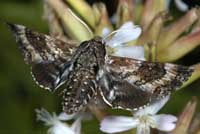 |
The upperside of the forewing is dark brown with a dusting of white
scales. Some moths have patches of reddish or yellowish brown on the
wings.
|
 | The upperside of the forewing is gray with heavy black bands. The upperside of
the hindwing is brownish gray with no markings.
|
 |
Lintneria eremitus
WO, the
Hermit Sphinx
The upperside of the forewing is gray-brown with wavy lines,
black dashes, and one or two small white spots near the center of
the costa. The upperside of the hindwing is black with two white
bands and a triangular black patch at the base. Note the golden hair
on the thorax.
|
 |
Manduca quinquemaculatus
WO,
the Five-spotted Hawkmoth,
The moth abdomen usually has five but sometimes six pairs of
yellow bands. The upperside of the forewing is blurry brown and
gray. The upperside of the hindwing is banded with brown and white
and has two well-separated median zigzag bands.
|
 |
If you grow tomatoes, you have probably encountered Manduca sexta
in the larval stage.
Larvae get very large and can strip a tomato plant. (generally more southerly; unlikely)
|
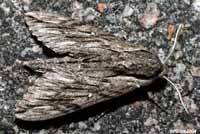 | The upperside of the forewing is gray with indistinct black and
white markings. There is a series of black dashes
from the base to the tip, and a small white cell spot. (generally more southerly; unlikely)
|

|
Sphinx canadensis
WO,
Sphinx canadensis, the Canadian Sphinx, is not common, and is not
often reported anywhere. The absence of the white spot on each forewing and the more brownish coloration serve to separate canadensis from S. poecilus.
The hindwing fringe also tends to be white on poecilus and checkered brownish on canadensis.
|
 |
Sphinx chersis
WO, the Northern Ash Sphinx or Great Ash
Sphinx
The upperside of the forewing is soft dark gray to blue-gray with a series of black dashes, one of which reaches the wing tip. The upperside of the hindwing is black with blurry pale gray bands.
|
 |
The forewing is dull slate grey with considerable light grey scaling in a broad band along the costa about 3/4 of distance from body toward the apex. Median lines are black and thin. There is a wavy, diffuse dark subterminal line,
inwardly bordered by white, and a whitish bar in terminal area, paralleling outer margin.
|
 |
Colouration and markings are highly variable from one specimen to another.
The fringes on forewing are mostly black with some white; those on
the hindwing are mostly white with a few black patches.
|
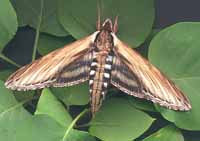 |
The lower forewings are predominantly brownish-yellow with a fairly
wide dark bar along the inner margin. At rest the wings hug the
body, giving the moth a long slender look.
|
 |
Sphinx luscitiosa
WO,
the Canadian Sphinx or Clemen's Sphinx
The upperside of the forewing is yellowish gray in males and pale gray with a faint yellow tint in females. In both sexes, the dark border on the outer margin
widens as it approaches the inner margin.
|
 |
If you have blueberries in the woods, then you probably have the
Poecila Sphinx.
|
Smerinthini Tribe:
 |
Amorpha juglandis
WO, the Walnut Sphinx
The adults are also highly variable; sometimes wings of an individual may be all one color or may have several colors, ranging from pale to dark brown,
and may have a white or pink tinge.
This is the first Sphinx species I reared as a boy in New Jersey.
See the file for the female; she is different.
|
 |
Pachysphinx modesta
BAMONA,
the Modest Sphinx or Poplar Sphinx
This moth has a large, heavy body, and females can be remarkably plump.
They are common on Prince Edward Island. I rear some almost every year.
|
 |
Paonias excaecata
WO, the Blinded Sphinx.
Fw outer margin is quite wavy. Dark cell spot and dark oblique line mid wing from costa almost to inner margin. Basic ground colour is pinkish brown.
At rest lower wings are almost completely hidden.
Males demonstrate a strong curve to abdomen.
Moth gets its name from the blue-gray pupil surrounded by black, with hot pink wing scales in hw basal area.
|
 |
Named for the small eye-spot in the hindwing.
Both sexes rest with wings parallel to the resting surface, with the upper lobes of the hindwings protruding above the forewings.
|
 |
Smerinthus cerisyi
WO, the Cerisyi's Sphinx
Smerinthus cerisyi, the one-eyed sphinx or Cerisyi's sphinx, (wingspan approximately 95mm) closely resembles Smerinthus jamaicensis, and
in northern regions the two species overlap. This is a very easy Sphinx to rear.
|
 |
Smerinthus jamaicensis
WO,
the Twin-spotted Sphinx.
Jamaicensis closely resembles cerisyi, but jamaicensis is much smaller with larger blue patches on more vibrant and deeper purple in lower wings.
Note complete (i.e. outer margin to outer margin) off-white arc just below forewing apex. In cerisyi lower portion of arc does not return to outer margin.
|
Macroglossinae subfamily
Dilophonotini tribe:
See Hemaris comparison to help distinguish
the next three species.
 |
Hemaris diffinis
WO, the Snowberry Clearwing or Bumblebee Moth.
Hemaris diffinis is a very variable species, but almost always the abdomen sports contrasting black and yellow hairs, the ventral surface being quite black. The legs also tend to
be quite dark and there is a black mask running across the eye and along the sides of the thorax.
|
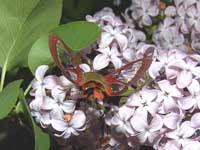 |
Hemaris gracilis WO, the
Slender Clearwing or Graceful Clearwing
Hemaris gracilis is distinguished from similar species by a pair of red-brown bands on the undersides of the thorax, which varies from green to yellow-green dorsally and sometimes brown with white underneath. They have a red abdomen.
|
 |
Hemaris thysbe
WO, the Hummingbird Clearwing
It is not difficult to see why many gardeners would mistake an Hemaris thysbe moth for a small hummingbird as it hovers, sipping nectar from flowers through a long feeding tube.
|
Philampelini tribe:
 |
Eumorpha achemon
WO,
the Achemon Sphinx
TThe forewing is light grey and brown with many lines, and there are dark patches near the middle of the inner margin, near the apex and near the anal angle.
The entire basal area of the hindwing is pink.
|
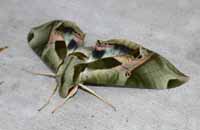 |
If you have Grape or Virginia Creeper nearby, then you might have
this species.
I often get asked to identify larvae from areas not
previously reported.
|
Macroglossini tribe:
 |
Amphion floridensis
WO,
has two bright yellow bands on tufted abdomen. At rest, dark red-brown upperwings hide red-orange median band and yellow spot of hindwings;
in some Amphion floridensis the median band may be very pale or almost absent.
Concave regions of fw outer margin also have pale yellow markings in fringe area.
|
 |
They are common in New Jersey and common
here on Prince Edward Island.
You will often see this species listed as Darapsa pholus,
especially in older literature.
|
 |
Darapsa myron
WO, the Virginia Creeper Sphinx or the
Grapevine Sphinx. Fw upperside dark brown to pale yellowish gray, with an olive tint (often very green).
On the costal margin there is a dark rectangular patch, although this may be reduced or absent. The upperside of the hindwing is pale orange.
|
 |
If you have hydrangea growing near a stream, then you may have the
Hydrangea Sphinx.
|
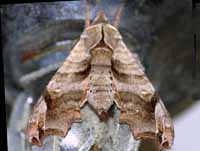 |
The moth's outer margin of the forewing is deeply scalloped.
The upperside is light brown with dark brown markings.
There is a small black and white spot near the tip.
The upperside of the hindwing is orange-brown with a dark brown outer margin and median line.
|
 |
Hyles gallii
LE, the Bedstraw Hawk Moth
or Gallium Sphinx
Hyles gallii ranges coast to coast in Canada (into the Yukon) and southward along the Rocky Mountains into Mexico.
It is also widely distributed throughout Europe and Asia.
|
Hyles gallii, August 17, 2011, Linda Eastman.
 |
Hyles lineata
WO, the White-lined Sphinx
The forewing upperside is dark olive brown with paler brown
along the costa and outer margin, a narrow tan band running from
the wing tip to the base, and white streaks along the veins.
|
 |
Proserpinus flavofasciata
WO, the Yellow-banded Day Sphinx:
Fw upperside is medium to dark brown with a faint to distinct white median band.
Hw upperside is dark brown with a wide orange median band which may not reach the inner margin. The moth mimics a bumblebee.
|
 |
This moth is very much under reported across the United States. It
is a rapid day flier so is probably not in too many collections.
Grape is a popular larval host.
|
|
|
|





































